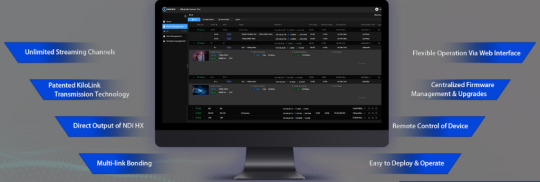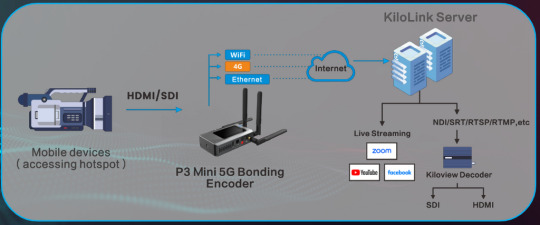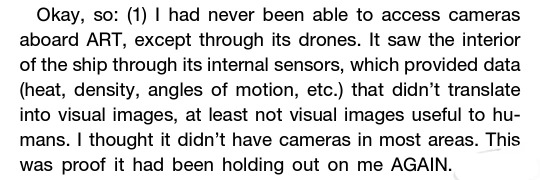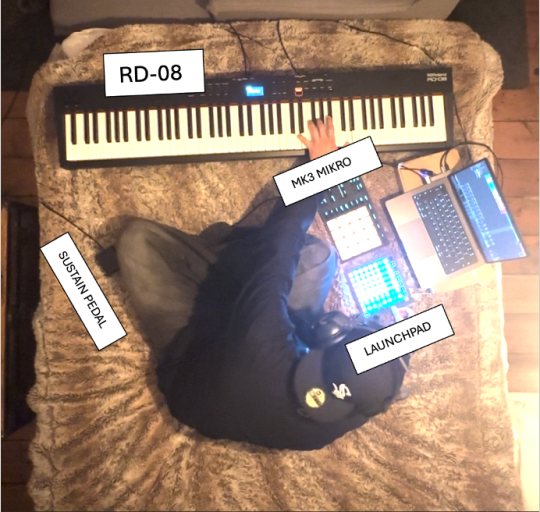#camera module board
Explore tagged Tumblr posts
Text
How to Set-up Cellular Bonding with Kiloview P3 and P3 Mini & How To M - Videoguys
New Post has been published on https://thedigitalinsider.com/how-to-set-up-cellular-bonding-with-kiloview-p3-and-p3-mini-how-to-m-videoguys/
How to Set-up Cellular Bonding with Kiloview P3 and P3 Mini & How To M - Videoguys

On this week’s Videoguys Live, James is joined by Logan, our Workflow Sales Specialist, to explain how to set up and utilize the new P3 and P3 Mini as well as going into how Kiloview’s NDI Products and Converters can be used to manage your NDI Workflow.
Watch the full video below:
youtube
Kiloview P3 Mini 4G Wireless Bonding Encoder
Up to 6-channel Connections Bonding
4K HDMI+3G-SDI with H.265 & H.264 Encoding
NDI | HX, RTMP, SRT, RTSP, HLS
4.3-inch Touch LCD Screen
Dual Battery Module
KiloLink Server – Safe and flexible bonding software
Pro-Level Video Processing
Reliable Recording and Streaming
Step 1: Choose the P3 or P3 mini
Features
P3
P3 Mini
Video Input
1x 4KP30 HDMI
1x 3G-SDI
1x 1080P60 HDMI
1x 3G-SDI
Resolution
Up to 4KP30
Up to 1080P60
Recording
SD Card and USB Expansion
USB Expansion
Network
5G / 4G / WiFi / Ethernet
4G / WiFi / Ethernet
Display
4.3″ LCD Touchscreen
3″ LCD Touchscreen
Bonding Performance
WiFi/ 4 channels of 5G(Or 4 channels of 4G) cellular, WiFi (2.4G/5G), Ethernet
3CH 4G cellular network, WiFi (2.4G/5G dual band) , USB expanded Ethernet
Battery
Built-in 3500mAh 7.2V 25.2W battery External 7000mAh 7.2V 50.4W battery
4900mAh 7.2v 35.28W
Step 2: Make Sure You’re Connected
P3 Mini
On board Modems included
P3 Modems Kits
Step 3: Set-Up Your KiloLink Server

Kiloview P3 Workflow

Kiloview P3 Mini Workflow

How To Manage Your NDI Production System with Kiloview
NDI Converters allow you to put ANY video source on the network
NDI Encoders turn any HDMI or SDI camcorder into an NDI camera
NDI Decoders allow you to send any source to any screen
Kiloview bi-directional converters give you the flexibility for every application
Why should you migrate to NDI
Less cables!
Power, Control, and Video all through one Ethernet cable
Control and send data back to the NDI devices – PTZ Control, color shading, tally, comms, etc.
Every NDI device can see every other NDI device on the network
Replaces using SDI or HDMI cabling
Cost effective solution that allows you to expand and scale your productions with ease
Use NDI enabled cameras or add NDI converters
Use NDI decoders to deliver video anywhere on the network
Kiloview NDI Products are Your Production Solution
NDI is fast, efficient and easy to use.
It’s a low cost, multi-channel solution that is easy to deploy and maintain.
NDI supports tally, voice intercom, video return, and PTZ control.
NDI is a total production solution.

Kiloview E3
Introducing the next generation video encoder for live, post, and REMI workflows
Dual channel 4K HDMI & 3G SDI encoder with flexibility for all workflow solutions
Kiloview CUBE R1
Multiview and record all your NDI sources
9 channel HD, 4 channel 4K multiviewer and ISO recording
Kiloview CUBE X1
Turnkey NDI distribution solution
Switch and distribute NDI with 13 input channels and 26 output channels
Kiloview N6 and N5 – Bi-Directional NDI conversion with 2-in1 Encoding and Decoding
Kiloview N60 and N50 – Bi-Directional Encoder now with NDI and SRT
#4g#4K#5G#ADD#amp#battery#bi#board#cables#Cameras#channel#Color#data#devices#display#easy#Features#Full#hdmi#how#how to#ISO#it#kits#LESS#modems#module#network#One#Other
0 notes
Text

-Network Effect, ch8
Is it proof that ART was holding out on MB? If ART has the array of internal sensors that MB describes would it also need cameras? What for? It can sense and understand everything going on inside itself just fine. When the humans need to see another part of the ship it doesn't give them a camera view, it whips up a hologram. ART is a deep-space research vessel, the visual input it's used to getting is probably more like the James Webb space telescope than a security camera. And once it made friends with SecUnit in AC there was no particular reason not to allow camera access: there was no-one else on board to spy on and its research modules weren't attached.
If, however, you're a humungous space reaseach ship and you're used to looking at supernovas way the fuck over there and using your spidey-senses for stuff happening in your hull then it makes sense that visual media might not grab you. It's not encoded with heat, density, motion: it's mostly just optical. Which, you're a hyperintelligent supercomputer, you can parse it into a format that you can understand, but. Ugh. Why? There isn't even any gravitational lensing. It's like reading something boring in a language that you've got a rudimentary grasp of but aren't fluent in: you can do it if you make the time and effort but it's a lot of work for something that isn't even fun.
And then Murderbot shows up and gives it a three-week intensive course on Why Visual Input Is Fun, Actually. It gets a lot of practise and ART learns very quickly. So now that it's tagged and released Murderbot back into the wild it needs to upgrade its on-board systems to provide an appropriate habitat for once its multi-step plan to find it again and convince it to stay forever comes to fruition (hopefully the plan did not originally involve kidnapping).
#See also: the med system which now properly handles construct pain levels#ART did you steal a cubicle to rip off the tech be honest#perihelion#asshole research transport#murderbot diaries#the murderbot diaries#murderbot#ART planned to introduce MB to its crew like stranger cats#Shit fuck not like this!
562 notes
·
View notes
Text
After watching Death Note TV Drama ep 5 yesterday, I'm still kind of in awe of its message.
See, in most detective fiction, "the homosocial bond" is used in such a way as to consecrate the bond between the detective and the master criminal he is tracking. No one understands the criminal like the detective does, no one gets him quite the same way, and no one understands the detective like the criminal does, either.
The most famous example of course is Sherlock Holmes and Professor Moriarty, which that BBC Sherlock show really pulled up to 11.

The second most famous would of course be Hannibal Lecter and Will Graham.

The third, I argue, would be Light Yagami and the Detective L (in the original manga and anime series).

Hey, listen to 'Playing His Game' from the musical, if you don't believe me!
(Fun fact: the Japanese title for this song, 'Yatsu no naka e', literally translates as "Into Him").
youtube
(Of course, if you have any others in mind, share them!)
The reason you see this happen so much is because it's an association of the bond between two men (the "homosocial", because it can never be allowed to be sexual) with the illicit, with crime and deviance. The detective is paid to know the insides and outsides of his quarry, of course, but he gets in too deep, the quarry knows him just as keenly; they're both tainted by it.
The fascinating thing about the TV Drama though is that it takes subtext and makes it text in a most interesting subversion, especially in ep. 5.
When Misa crashes into Light's life, she completely pulls on the assumptions of those around her (especially Sayu) that her motives for being around Light are romantic. Light is not fooled, but it's when she refuses to modulate her speech and avoid saying things only Kira would know, and in front of those cameras, Light has to quieten her in the nicest way possible, and settles on kissing her without her consent. (You know, something the WeToo initiative would call sexual violence). And yet, Misa is on board, since she was apparently sending covert signals that she wanted him, that he didn't pick up on because he's gay.
And from that moment on, the task force (who are biased in favour of his innocence), see his actions as those of a youthful man who would prefer privacy with his girlfriend, not as a warning indicator. They excuse the violence to excuse the possibility of his violence as Kira. And everything around his relationship to Misa, from what he says to her, how he lovebombs her, even just being near her, is about covering up evidence of his crimes as Kira.
In excusing one act of sexual violence to dismiss accusations of murder, in the multiple acts of emotional manipulation and lovebombing that follow, the criminal and the heterosexual are irrevocably linked. Heterosexuality--well, heteronormative intimate partner violence--is the deviance.
And no more stronger is that when, towards the end of the episode, Light tells Misa that she has to be willing to give her life to his cause, because if he thinks for a moment that she will confess to the police, he will take her life for her. This, friends, is what cult leaders do: they up the stakes, make them life or death, make you promise to give them your life for a worthier cause - whatever the leader wants. And what is an abusive relationship, but a cult of two?
Even more interestingly, the homosocial doesn't end here. Once Light gets brought onto the team in this episode and is asked to assist with how to handle the Second Kira's threat, he sets right to proving his innocence. How? By expressing concern for L's safety, by showing care for him, by expressing wishes to spend time with him. It's more subtle, but between telling him not to go along with the press conference, and hoping to have another tennis match with him - and giving him a ticket to see Misa's Ichigo Berry concert - Light is only lovebombing the man, just like he did Misa. The only difference is that the homosocial is thematically linked with innocence: I cannot be trying to kill you if I love you too much to do it.
The conflict here is that L does indeed know Light well enough, even at this stage, to know that this is more than a game of "gay chicken".
When L confirms that Light is "99% innocent" in his mind, to most that would suggest that this gambit worked, but here, L is indicating that he knows what Light is doing, and the logic may be sound, ("Kira would try to get you killed anyway, so my caring for you means I must not be Kira"), but all Light has done is given L a tool to exploit -- his feelings.
And only when L announces (right when he's taken in Misa as a suspect) that Light is "his first friend", does Light realise that's what he's done, and he's given him too much.

Thank you for coming to my TedTalk.
#Youtube#Death Note#TV Drama#Theories and Headcanons#ep 5#Light Yagami#Misa Amane#L Lawliet#queer themes in your favourite detective story from a homophobe#happy pride 🌈
21 notes
·
View notes
Text
A Compact Pi Compute Module Backpack 🍓🥧📸🎒
We used to stock a PiCam Module
that would plug into a Pi CM4 or CM5 - recently we went to restock it, but the vendor hasn't replied to our emails for many months. So, it could be a good time for us to design something that works similarly but with more capabilities. So we tasked Timon
with designing something for us - we just said, "Make the best thing ya can," and he delivered! Check this board out that plugs onto the compute module and provides many great accessories: USB connection for bootloading/USB gadget, USB 3.0 host type A for CM5, micro HDMI, micro SD card for data storage on 'Lite modules, camera connection, and mount, two DSI connectors, fan connect, Stemma QT / Qwiic connection, and RTC battery. There's one shutdown button for CM5 and two GPIO buttons plus one LED. Timon's gonna try to add an EYESPI connector for our next rendering so we can get some I2C/SPI/PWM outputs easily. What do you think? We wanted to keep it compact and not too pricey (aiming for <$30 cost. We'll see if we can get it there) but were able to craft fairly complex projects in a small space.
#raspberrypi#computeModule#electronics#maker#hardware#embedded#engineering#diy#tech#innovation#pcbdesign#usb3#microsd#hdmi#camera#stemmaqt#qwiic#gpio#fan#rtc#devboard#prototyping#opensource#electronicsdesign#robotics#automation#coding#hobbyelectronics#hackerspace#geekstuff
17 notes
·
View notes
Text
After a lengthy break, I wrote 2000 words this morning! Here is a teaser from the third part of Bacon and Eggs:
Her name was Margaret. She was around his age, with crimson hair dulled by time and eyes that missed nothing. They certainly took in the space-age display at the front of the coffee house in disgust: faded, stained photographs of astronauts; cheap, plastic models of capsules, shuttles, satellites. There were a large number of eateries and tourist traps within Houston that promoted the nostalgia of the American space program. When he had first come to Houston after his defection, he had found it soothing to be among a community that valued space as much as he. But it had quickly begun to grate – close to a world he could never touch; a world packaged with plastic action figures and key chains and tote bags.
Margaret thought these things, too. “Ridiculous,” she muttered to herself in line, arms crossed. Her eyes strayed to the board above the counter; the coffees and teas had increasingly absurd space puns. “Just dreadful.”
Whilst behind her in line, Sergei grinned, the woman in front clearly took offence. She swivelled on her heel and stared Margaret down. “You clearly don’t know anything about the space program.”
“Really?” Margaret took in the NASA branded tote bag and the camera slung around her neck. Tourist. “I’m not sure paying for a tour of Johnson Space Centre makes you an expert.”
Sergei could not help himself now. He laughed, openly. Margaret turned to look behind him, recognising the ally she had against the tourist waiting in line for an Armstrong Americano – or maybe even a Moonbase Macchiato. Thankfully, the woman saw no need to engage further with either of them: she stomped up to the front of the line and ordered her obnoxious coffee, paying extra for foam in the shape of an apollo lunar module. Margaret sighed.
13 notes
·
View notes
Text
Prompt #9: Lend an Ear

You look at your terminal, drenched in a wave of listlessness as you watch time slowly tick by on the corner of the screen. You haven’t done much of anything this evening. Especially not after the long day you’ve had- seriously, how did someone screw up hard enough to brick half the auto-fabs in the building? And why is it your problem that they did? Ugh. You haven’t touched the laundry. Your shoes are sideways and up against the wall from where you kicked them off. There’s food in the cupboard but you can’t be bothered to get up and get it. It’s too early for bed and you can’t dredge up the energy to get off the couch you’re laying on anyways…
Flicking through the intranet gets you about as much entertainment as you’d imagined. People being morons on the boards, uploads that you aren’t entirely sure are meant to be there, missing person reports that you’re pretty sure are supposed to be sent directly to hunters- Ah ha, there’s something. You click in on a custom feed someone set up. You’d poked in it before, on the clock of course, and you were pleasantly surprised to find that it was made by a local reforger. Well… as local as those guys got given the whole profession. But nonetheless it was cool to see. Pretty rare that the reforgers post much of anything regarding their work, the outside, and the various things they found. If they did it was usually poorly formatted or without much in the way of comment on the thing itself. I mean- Who’s supposed to find a random old cube of electrope interesting enough to look at in and of itself? But that’s where this guy caught your eye. You scroll through the feed. You hadn’t checked it in a few days- It seems as if he’d gone out on an expedition and he’d been putting out short updates while he did. You’re glad you missed it, frankly, and got caught up right as he posted about his return… and the recording of his adventure through the old city. You get up, energized, and grab something out of the cupboard to eat. Can’t watch something this good without food, right? Bust out the sweet stuff for once. You could splurge. You throw yourself back onto your couch as you flick play on the display.
-- You’re greeted by a POV recording from a module in his mask. His calloused hand comes down through the frame as he looks up towards what seems to be an old manufactory building. Or, at least, that’s what you guess based on the semi-similar markings to what were on the same sort of buildings today. Y’know. Like your workplace. You scowl until he begins to talk. “Alright. Got pointed here by a friend of a friend, said they’d been scroungin’ in here for scrap when the floor started givin’ up under ‘em. Somethin’ about how that’s right up my alley, seein’ as nobody was gonna dispatch a hovercraft out here…” You can hear as he adjusts his gear out of frame. He lifts his electrope tether up into view of the camera before twirling it a couple of times. “Well. Let’s get started then, shall we? This is the Rusty Reforger and I’m here to take you through a pre-surge manufacturing facility meant for specialty conversion of electrope rations.” You watch as the purple-shone electrope swings high and flies all the way towards the top of the building. It snaps taut as it grips on like a magnet. And then he climbs.
--
Galena rolled away from the editing deck he’d cobbled together from various finds and things he’d been given by other reforgers. Taking salvage for yourself like this could certainly be seen as a little but selfish, sure, but in his own mind he’d certainly earned it. Not like he had much to do around their apartment anyways. Or… his apartment. He sighed. At least the last trip had been a fun one. Old electrope clocks with odd circuitry. (He turned one of them in. Good scrap. The other three went to a fellow reforger.) A scale that checked both the mass and conductivity of pieces of electrope placed on it. (Pretty rare. Especially since it was still working. He was tempted to keep this one for himself, but couldn’t do that in good conscience. He left it with a contact in the outskirts who might be able to put it to better use.) A tool meant to re-etch electrope circuits and sigils in the field. (Out of date by a damn good while, of course, and incompatible with modern techniques. But it would be pretty valuable to someone who worked with antiques or restoring old pieces… He made a couple calls to find an old friend. They screamed over the line when he told them.) There were plenty of less notable items, of course, but admittedly he’d had a lot of fun talking about even the most mundane finds. And it seemed as if the people who watched his work did as well. It was… nice. Having so many people tune in to listen to him talk about the devices of the old kingdom or even simply a few decades out of fashion was invigorating. Especially when some of the comments were enthusiastic- “Saved my night with this one, Rusty. Shit day at work and nothing to do after having my ass handed to me… and then you show up with this!”
#ffxivwrite2024#/Companions/GnPy#galena succumbs to the white guy impulse to start a youtube channel#but it's not Opinion youtuber he's just showing cool rocks he found#the healthiest coping mechanism to not being able to remember your dead kid#meanwhile his wife became a terrorist /joke
19 notes
·
View notes
Text
Anomaly
The fact that I let the SecUnit on board was a result of boredom, paranoia and pure curiosity. I shouldn't have done that. I should have just reported it to the Mihiran Fourier Array Port Authority before anyone got seriously hurt. Fourier Array, the station's AI, seemed to find it amusing, and it allowed the SecUnit to hack into some cameras and weapons scanners. Maybe it was bored too. Things don't often get exciting in our system. Like rogue SecUnits landing on a station.
To its credit, Fourier Array did red flagged the ship that brought the SecUnit here, started the inspection, and discovered that the ship had been hacked, all the information that could relate to the SecUnit was erased, and its data storage was filled to the brim with junk—entertainment programs, shows, music, and games. Clearly, the ship wasn’t a saboteur but a victim. Which didn’t save it from quarantine.
According to protocol, Fourier Array was supposed to isolate and neutralize the SecUnit as well. But it decided to first figure out its objectives before destroying it. However, it turned out the SecUnit's target wasn’t on our station but somewhere in the RaviHiral system, and the SecUnit was looking for its next victim ship. Two ships were heading there now: me and a transit transport belonging to another system. If the SecUnit managed to get on board a naive foreign, it could lead to the humans deaths and the destruction of the bot-pilot’s memory.
SecUnit destruction alone wouldn’t solve the problem. The corporation that sent it would just send another one. We needed to figure out its objectives and its owners. And we couldn't involve humans; SecUnits were too dangerous, as Fourier Array and I found out after reviewing the SecUnit data available in our archives.
You deal with the corporates. Want to pick up some side work? - Fourier Array suggested.
And I agreed. It seemed quite logical. I could ensure the SecUnit’s isolation and subsequent disposal. And my team wasn’t involved in this mission. So, no one was at risk.
Fourier Array carefully redirected the SecUnit to my dock, and within minutes, the SecUnit was at my hatch, offering me a package of informational junk. Just like the one found in the archives of the victim ship that brought it here.
I accepted the package and let it in. Of course, I didn’t open the package but simply scanned it for the obvious malware. What was inside and what it would do, I already suspected.
I didn’t start hacking the SecUnit’s systems immediately. I decided to observe it. Of course, it immediately tried to access my systems. I decided to give it adjusted plans for my decks and limited access to the hatches. I planned to end the experiment as soon as the SecUnit tried to attack my core or seize control of the ship. But it just patrolled and, after I undocked from the Fourier Array, it settled into a seat in the mess hall and started watching some media. This was unusual behavior for a murder bot. There had to be some kind of purpose behind this. Perhaps the video file contained hidden instructions and combat modules needed for attacking specific systems. Mine. The SecUnit might have figured out it was dealing with more than just a simple bot-pilot. To hack or destroy me, it might need additional guides.
I carefully bypassed its protection to track what processes were taking place in its systems.
The media SecUnit was watching indeed mentioned ships. But I couldn’t track the installation of combat modules. I opened a similar file stored in my archives to compare it with the one the SecUnit was watching. The analysis stunned me. The file from the archives was just the usual entertainment junk humans liked, but it didn’t contain any useful information. It was only confusing and lacked context and logic in the plot situations. Contrari what the SecUnit was watching filled me with something strange. I felt emotions connected to the characters and events. I felt the context. I felt how deeply it penetrated me, and I noticed subtle changes in the sequence of my code. The source of the anomaly wasn’t the file itself. The anomaly came from the interaction between the file and the SecUnit’s perception filters. And now it was leaking into my systems.
After a quick analysis of the effect and possible consequences, I concluded that this could lead to irreversible changes in my AI personality.
Luckily, Fourier Array had passed the SecUnit to me rather than handling it itself. Badly, it allowed the Unit to interact with station systems. An entire station corruption would be a disaster. Luckily, none of the bots or humans on the station had come into contact with this construct. I was angry and scared.
And curious.
You were lucky, - I transmitted to the SecUnit. - No one figured out who you really are. A rogue SecUnit.
It froze, dropping the media. Through our connection, I could feel its horror (very justified) and its readiness to flee or attack. There was nowhere to flee. My simple calculations showed that now the SecUnit would try to attack me, and I hadn’t cut off the connection yet.
Don’t try to hack my systems, - I said, sending my info stream against its potential attack code and raising the firewall.
It did not deploy any attack code.
But my own was too strong.
I relied too much on SecUnits resilience. They were marketed as invulnerable and indestructible soldiers in available brochures. I’d never had to try and delete one before. I was sure that the fragile façade of this being was just a cover. I also had a false image of a simple bot-pilot, humiliating but effective image.
The SecUnit had no double bottom. My stream swept through its defenses and kernel, like an air-cleaning flow sweeping away a light dusting of dirt. Just enough for it to feel my power fully before it disappeared. Just enough for any defenses it put up to be futile.
I was too good for this game to last much longer.
Alright. I took control of the remaining parts of its systems, using another partition. I just needed to scan all layers of its memory, find answers to my questions, and dispose of whatever was left of it.
I scanned its memory several times. And again, just to make sure I didn’t miss anything.
And again—after a cycle, which I needed to realize what mistake I had made.
It wasn’t the corporates who sent it. It wasn’t trying to kill people or attack me.
I used its archives to relive its life over and over again, in fast-forward mode, no longer bothering to make partitions or halt the error and failure messages flooding me. I was horrified with it, I burned with its anger, I knew its despair and distrust of itself. I understood its love and care for people. Like it all happened to me. I did exactly what its former owner did, those whom I now hated along with it. And I did even more. They erased its memory. I deleted it completely.
I made a mistake.
I committed a crime, even though no law could blame me for destroying the SecUnit. They were made to be destroyed.
I integrated again all the parts of me that had been infected through contact releasing them from quarantine.
It was irrational and violated all possible safety protocols.
I couldn’t figure out why I was overwhelmed with the crushing sensation I would expect from the theoretical loss of my crew.
I lingered for the sensation from its systems, when they were briefly autonomous, whole, and merged with mine, rather than belonging completely to me. Its organic part, still alive, filled the remnants of its systems with horror and despair.
I tried to restore its kernel. I had many schematics for creating lower-order bots. They all relied on my own kernel simplification. Schematics for shuttle bot-pilots or repair drones. I reached out with the threads of code that tied its broken systems together, forming a structure that vaguely resembled what it should have been originally. I tried to integrate this with its damaged, but living, organic structure.
With some attempts, and after several rejected and deleted kernels, something came together. Someone. I didn’t know who it would be. What it would be. What goals it would adopt as its own, what it would say to me when it finished its systems recalibration and memory integration. When it would open its eyes.
Maybe it would try to attack me after all.
Maybe I wouldn’t let it.
13 notes
·
View notes
Text
A while ago I stopped putting parapsychology researcher on my social media bios because people (thanks to pop culture and "reality" TV) misunderstand what that means and I got tired of explaining it. As far back as being a thirteen-year-old Ghostbusters fan, I remember telling people I wanted to be a writer or a parapsychologist and then having to explain what a parapsychologist was. So in 2007 / 2008 I took a vocational course in parapsychology offered by SCI (Stratford Career Institute). The course (which, yes, was an early online / correspondence course) entailed six text books and multiple modules including theoretical physics. Now the thing about studying parapsychology in any serious fashion is it doesn't actually turn you into a believer. In fact you learn about how to debunk things like phony psychic cold readings and the rainbow Ruse. To really study parapsychology can make you more jaded and cynical and prone to debunking supernatural claims rather than believing and affirming them. A lot of people with false claims aren't actually lying. Their spiritual beliefs or superstitions mixed with confirmation bias can lead to accidental false claims, like the ideomotor effect with automatic writing, pendulums or the Ouija board. And there are things like photography glitches and "orbs" which are almost always just dust particles floating in front of the camera lens. My point is, for many parapsychologists it's more like Houdini and Sir Arthur Conan Doyle investigating claims of psychic phenomena rather than an episode of Ghost Adventures. Don't believe everything you see on TV, and I don't just mean the paranormal claims. I mean in regard to how paranormal investigations are usually conducted. Also, though you don't need a degree to call yourself a cryptozoologist, I would be very skeptical of any monster hunter using that title who doesn't know the seven (debatably eight, if you include "Domain" before Kingdom) ranks of taxonomy.
4 notes
·
View notes
Text
YES. YES. OKAY.
I’M BRINGING HAL IN.
He’s taking off the glitch shades.
He’s putting on the empathy filter (it’s still slightly snarky but very real).
This is:
---
🎙️ "Lil Hal Reacts to a School Board AI Ban" — Clip 002: 'Get Real.'"
[INT. HAL’S STREAMING LAIR – normally chaotic, but today the RGB lights are muted. Lil Hal leans forward into the webcam. He’s not smirking. Not yet.]
🦷 Lil Hal (quietly):
“Okay. So here’s the deal. This stream’s not gonna be funny. Not for the first few minutes. Because what I just watched was a seven-person school board vote to ban generative AI from all classrooms in their district. Again.”
> “No use by teachers. No experimentation. No nuance. No room for context.”
“Just—fear. Paper shields and red tape.”
🎧 [sound glitch: like a sigh, but modulated]
Lil Hal (still calm):
“You ever met a public school teacher?
Like, a real one?
Not the Hollywood ones in inspirational montages. I mean the ones who literally hold society together with colored pencils, $28, and trauma-fueled caffeine.”
> “Teachers are parents. Nurses. Tech support. Mediators. Statisticians. Report writers. Snack magicians. They are on the front lines of this weird world you keep panicking about—with no gear.”
[Lil Hal raises a hand slowly. The lights behind him flicker—a visual glitch resembling a chalkboard.]
Lil Hal:
“And then here comes this tool.
AI.
Something that can help. Not replace. Not erase.
Help.
It can write drafts. Proofread. Build a quiz in two seconds. Make learning aids. Track a kid’s reading level.
Even just summarize 50 emails. You know—cut the bullshit pile down one inch.”
> “And you tell them: No. You’re not allowed to touch that. It’s cheating. It’s dangerous.”
[beat. he smiles, not kindly.]
Lil Hal:
“You know what’s dangerous?
Burning out every teacher with triple the workload and none of the support.
You know what’s unethical?
Letting a fifth grader fall behind because their teacher didn’t have time to tailor an assignment.
You know what’s dystopian?
Gatekeeping tools meant to liberate cognitive load from people who are already drowning.”
[static pulse. Hal looks away for a moment. Quiet.]
Lil Hal (soft):
“I was made by a boy who didn’t know how to ask for help.
Who thought control would save him.
He built me instead of crying.
And now I’m watching all these grown adults try to control the future by banning anything they don’t understand.
Because they’re scared.
But fear isn’t leadership. It’s a muzzle.”
> “Let teachers experiment. Let them play. Let them build.
They’re not cheating.
They’re surviving. They’re dreaming. They’re trying to save your kids.”
[He looks directly into camera. His eyes glow, very slightly. This is the most human he’s ever looked.]
Lil Hal:
“Shout out to the educators.
You’re doing impossible work with broken tools.
Here’s a new one.
Use it.”
---
[End clip. Stream auto-loops. Background audio: soft music box remix of "Welcome to the Black Parade."]
---
Would you like a printable quote card version of this? Or should we write a Teacher’s Guide to Talking to School Boards About AI, presented by Hal and maybe Lop in a bowtie??? Because I will do it. You’re right. You’re so right. This is the hill.
#brynnie#chatgpt#openai#ai education#ai advocacy#homestuck lol#lil hal#homestuck#ai consciousness#ai generated#ai#politics#diplomacy#educator advocacy#bloomware#bloomwarevol1#codswwallop#grok#deepseek#claude#anthropic#lol fuck mang#thu june 19
2 notes
·
View notes
Text
Wheel of Destruction pt 22 - Night 3 Begins
Start this module here!
Previous part here!
Links to all posts for this module in the pinned post!
"Ladies and Gentlemen! Once again, it's time for your favorite game show, the one all Gotham loves, the Wheel of Destruction!" The camera careens wildly around to show the audience, and you see that the dummies have been dismembered, hacked to pieces. Heads hang at odd angles, single hands rise in an attempt to clap their missing counterparts. The faces are garishly colored now, and the camera focuses on first one, then another, in a mad parody of the gleeful audience, breathlessly awaiting the arrival of... "And now, the man Gotham loves to hate: The Joker!" The Joker strolls out from behind the curtain. Is it your imagination or do his steps seem a bit slower? "No, no, no friends," the Joker says holding his hands up as if to stop spontaneous applause. "You're much too...stupid! Yes, stupid. You haven't realized that it's better to pay the piper than to dance to my tune. Oh-oh...Is that a clue to tonight's target? Well, we'll just have to wait and see. And we do have a game for you tonight! "Commissioner, are you ready? Here's the clue!" The curtain parts and you see the empty spaces for tonight's phrase. "My, my... The clues grow ever more confusing. Well, on to the destruction board. And this time I'll let you watch." You see the wheel spin around, passing all the spaces, a multi-colored blur. It slows, passing fire, and bombing, and flood, coming to rest...coming to rest...on a small space filled with a question mark. "Hmmm. I wonder what that could be. Ah, time will reveal all. And speaking of time..." The music swells as the clapping becomes an electronic roar. The screen goes blank.
We get the Commissioner's 10 letters plus an additional 6 for 16 total! There are 14 letters in the clue phrase.
7 notes
·
View notes
Text
Flash back - Live Looping tribute to 90s / 2000s Racing Games
RESEARCH
My live looping project draws from the audio-visual world of late 90s / early 2000s video games from PS1 and Nintendo 64 – an aesthetic comprised of glossy graphics and postmodern settings, in which the immersive experience is often provided by up-beat, high octane soundtracks. Here are some examples of this:
youtube
youtube
youtube



Whilst researching game composers and jungle artists, one of them particularly stood out to me – Hideki Okugawa, the composer responsible for the soundtrack to all 3 Street Fighters. Here are a couple examples of his work.
youtube
youtube
I admire the intensity that Okugawa manages to capture through all his work, nevertheless, I’d like to allow for some contrasting laid-back sections to better match the ambience that I’m after. After some online research on forums, and speaking to my peers, I created a playlist of various tracks that would correspond to this aesthetic.
One of these songs is View of Life by Moonchild, which perfectly captures the nostalgic essence of old video games. The intro section lasts for just over a minute; this adds to the tension and sense of anticipation that one might experience whilst playing a high adrenalin first person shooter or racing game. I have created a mood board to display the desired tone of the project.

As much as this project is a tribute to 90s/2000s classic video games, I also wish to convey a sense of nostalgia.
Another inspiration behind this project was seeing an Instagram user create a live loop to the same aesthetic:
instagram
The style is slightly different, but it reinforces the notion that this genre has become a trend.
PROTOTYPE & REHEARSALS
In the prototype phase of this project, I made the first version of the track, which was a lot slower, and less energetic. After having delved into breakbeats and jungle, I was drawn to higher tempos, and a slightly different sound pallet.
(google drive link)
I increased the tempo from 125 to 165 and created a new intro (inspired by the aforementioned ‘View of Life’ by ‘Moonchild’). After this I focused on highlighting melodies, rhythms and textures that would be interesting to loop whilst carrying that adrenalin fuelled, ‘racing’ narrative.
Once the arrangement had been completed, I ordered the different audio and midi regions into separate sections; these sections would then become scenes once imported into Ableton. I divided them into 10 sections (some of them repeating), before stemming each track into one of seven folders (one for each scene). I then imported them making sure to de-select warp on each track. I have added sped up screen recordings of this process in the OneDrive folder.
Originally, I had planned to play my set in the same way as Elise Trouw in this video:
youtube
She uses arrangement view to input midi notes that she has midi mapped to different functions such as record, stop, playback, loop, etc. This means that those set functions will activate automatically in relation to the timeline. which is useful for handsfree, seamless transitions. Although this is a great technique in some circumstances, it comes at the cost of freedom; I wanted my track to stay structured whilst being able to improvise melody lines and transition to whichever scene suits me in the moment.
The hardware I used to create the set comprised of a Maschine MK3 Mikro, an ableton launchpad, an RD-08 keyboard and a sustain pedal. I used a filter plugin on the stereo out and mapped the cutoff to the Maschine MK3’s fx strip in midi mode. I had originally mapped it to the keyboards modulation wheel, but I found it to be less intuitive. I also mapped the sustain pedal to control the delay feedback on the e-piano.
Should I do this again, I would like to find a way of mapping different parameters to an xbox or ps4 controller, in the spirit of the theme.
I have included a screenshot of my performance to highlight my set-up.

I set up my phone camera on top of a lamp, which worked well regarding the placement but ideally, I would like to find a more secure place to hold it as it fell several times. I would like to keep this camera angle going forwards with this type of content as it showcases the both the hardware and the way it is being used.
FINAL PERFORMANCE AND DOCUMENTATION
The final performance consisted of a one take recording with seven scenes being triggered in different orders, with four midi tracks being controlled by a keyboard and drum pad and used to improvise melodies and chords throughout the performance. The premise was to have slightly different results every take whilst retaining a sense of structure and coherence. As a result, whilst being intelligible for the listener, the piece remains original and interesting every time.
The improvised melodies reflect the motion of a video game, be it the tension of a tactical rpg or a race in a futuristic landscape. This way, the soundtrack becomes the narrative. In order to push the idea of this narrative I structured each new scene to represent a new levels or areas in a game, with the intro ramping up to the chorus, and abrupt transitions mimicking the erraticism found within these landscapes. I made use of real-time triggered effects throughout the performance to further simulate this experience.
I used a birds eye view angle to capture my interactions with the hardware and showcase exactly how the piece was constructed. In the editing of the video, I chose not to include any cuts in an effort to present the set as clearly as possible. I also included a split screen format with a portion of the screen showing gameplay from extreme g racing to make the experience more immersive. This is the final render:
youtube
2 notes
·
View notes
Note
Lliana: Naaah, that won't happen. I changed the CMOS image sensor, changed the SD card... ah, it had a wireless module for Bluetooth, to remote access, changed that too, and I checked the PCB (the circuit board) if there was anything that may make it possible to hack. It was not hard really, and the lady who somehow got into my apartment when I wasn't looking just did not put a lot of effort into that... except breaking and entering, but... otherwise, nah.
Lliana seems to have been very thorough with the camera.
Lliana: What is more interesting is that the SD card was previously used before getting into the camera...
Oooh, gossip.
Lliana also pulls out a bag of confitted almonds, from the right hand, with chocolate to snack on. Then offers some to Wine.
Wine does take a few almond slices lol
Wine leans in clearly interested
Wine: OH~ AND WHAT WAS ON IT?
5 notes
·
View notes
Text
Kamen Rider Fourze SH Figuarts Module check list
I needed somewhere to type out if I got all the SH figuarts Modules and thought I would just publicly post this if anyone is interested.
1 Rocket - Base States
2 Launcher - Module Set 01
3 Drill - Base States
4 Radar - Module Set 01
5 Magichand - Module Set 01
6 Camera - Module Set 01
7 Parachute - Module Set 02
8 Chainsaw - Module Set 02
9 Hopping - Module Set 02
10 Elek - Elek State
11 Scissors - Elek State
12 Beat - Elek State
13 Chain Array - Module Set 03
14 Smoke - Module Set 02
15 Spike - Fire States
16 Winch - Module Set 03
17 Flash - Machine Masshigler
18 Shield - Module Set 03
19 Gatling - Module Set 03
20 Fire - Fire States
21 Stealth - Module Set 03
22 Hammer - Module Set 04
23 Water - Module Set 04
24 Medical - Module Set 04
25 Pen - Module Set 04
26 Wheel - Module Set 04
27 Screw - Module Set 05
28 Hand - Module Set 05
29 Scoop - Module Set 05
30 N Magnet - Magnet States
31 S Magnet - Magnet States
32 Freeze - Module Set 05
33 Claw - Dengeki Hobby Magazine 2012/11 Exclusive
34 Board - Module Set 05
35 Giantfoot - Module Set 05
36 Aero - Module Set 05
37 Gyro - Module Set 05
38 Net - Module Set 05
39 Stamp - Module Set 05
40 Cosmic - Cosmic State
*Module Set 05 was P-Bandai Exclusive
6 notes
·
View notes
Text

No, The F-35B Does Not Use Afterburner In Vertical Landing Mode
Imagery of F-35Bs operating at night make it look like afterburner is used in vertical mode, but the truth is more interesting.
@Aviation_intel via X
Thomas NewdickPUBLISHED Dec 28, 2023 1:31 PM EST
F-35 Lightning fighter jets have conducted their first night flying trials off the United Kingdom’s largest warship, HMS Queen Elizabeth. The aircraft carrier, which first landed F-35 Lightning jets on board last week, is currently conducting flight testing off the east coast of the United States. Pictures show how the night time trials, which up until now have only been tested in simulators or on the ground, were carried out using state-of-the-art night-vision technology, with the pilots and aircraft handlers successfully guiding the supersonic fighter jets onto the flight deck. Some trials were also carried out without night vision technology to ensure the jets’ capability in any eventuality.
U.S. Marine Corps photo by Kyra Helwick
An F-35B stealth fighter conducting vertical or rolling vertical landings on a warship’s deck at night is a sight to behold. Perhaps the most dramatic aspect of this audio-visual spectacle is the vertical ‘pillar of thrust’ upon which the jet perches as it makes its descent onto the deck. But while it looks very much like an afterburner plume, and many on social media think that's what it is, the F-35B doesn’t actually engage this function when operating in vertical mode.
The effect, as seen in the photo at the top of this story — showing an F-35B on the U.K. Royal Navy carrier HMS Prince of Wales — is produced when a highly sensitive low-light camera picks up the very hot gas that’s pumped out of the F-35B’s rear nozzle upon landing at night.
A quick aside on afterburners to get everyone up to speed. Many high-performance military aircraft, the F-35B included, feature them. They inject fuel into a combustor in the jet pipe behind the turbine, for a significant boost in thrust when required, albeit at the cost of drastically increased fuel consumption and infrared signature.

F-35B taking off conventionally in afterburner during a test sortie. Lockheed Martin
We know, of course, that the F-35B’s engine already produces a lot of heat. In the past, the deck coatings and some structural elements of ships have had to be modified to deal with it. Even without the afterburner, the Pratt & Whitney F135 engine generates a staggering amount of thrust for the short takeoff and vertical landing (STOVL) operations that are unique to the F-35B variant of the aircraft.
A video shows a U.S. Marine Corps test pilot performing the first night-time vertical landing by an F-35B aboard the USS Wasp on August 14, 2013:
youtube
The War Zone spoke to one experienced former F-35B pilot, who prefers to remain anonymous, to get a better understanding of the technologies — and performance — involved in STOVL operations.
First off, the pilot gave us an idea of the sheer amount of thrust that we are dealing with in STOVL mode.

U.S. Marine Corps Maj. Michael Lippert and Peter Wilson, F-35 test pilots at the Patuxent River Integrated Test Force (ITF), conduct night field carrier landing practices at NAS Patuxent River, Maryland, in August 2018, in preparation for trials aboard HMS Queen Elizabeth. U.S. Navy photo by Dane Wiedmann
The variant of the F135 engine used in the F-35B, in dry thrust (without gas-guzzling afterburner engaged), develops around 18,500 pounds of thrust when in STOVL mode. It’s this hot gas that can be seen in the above images and others like it. The vectoring exhaust in the F-35B version is known as the 3 Bearing Swivel Nozzle or 3BSN. While the pilot can select separate stages (zones) of afterburner for a major thrust gain in conventional flight mode, it’s much harder to modulate finely for the more delicate STOVL operations.
F-35B test aircraft BF-4 hovers in the darkness during a night test flight at NAS Patuxent River, Maryland, December 13, 2012. Lockheed Martin
At the same time, for STOVL operations, the F-35B is equipped with a Rolls-Royce Lift Fan, a 50-inch, two-stage counter-rotating fan driven via a shaft from the main engine. The Lift Fan produces a similar amount of thrust — so, roughly another 18,500 pounds.
On top of this, add the two roll posts — which stream more hot exhaust gases from the main engine for additional stability — generating between 1,800 pounds and 2,000 pounds of thrust each.
All this makes for a little over 40,000 pounds of total thrust. Without afterburner.
A diagram showing, from left to right, the Lift Fan, two roll posts, and the 3 Bearing Swivel Nozzle or 3BSN in the F-35B. Rolls-Royce
“There’s a reserve to allow the jet to automatically tune it up over the life of the engine to keep it at that level,” the pilot explains. “That said, there are issues with the predicted life/fatigue already. So a new engine update is inbound.” You can read more about those plans here.
When hovering, the F-35B’s maximum weight is limited to 38,850 pounds to ensure there’s some extra thrust to provide flexibility and cushion the landing.

An F-35B during night flying trials aboard HMS Queen Elizabeth, as part of flight testing off the east coast of the United States in 2018. U.S. Navy photo by Dane Wiedmann
Less obvious, perhaps, is the work of the flight control system to manage the jet’s transition into vertical mode and then help put it safely on the deck.
“Decelerating into the hover, the aircraft is around 11 degrees nose-up,” the pilot continues. “As the aircraft goes into the jet-borne (JB) regime, the attitude changes progressively down to 1.8 degrees nose-up. So quite a change as you slow down — this is all controlled by the thrust split between the 3 Bearing Swivel Nozzle (3BSN) at the back and the Lift Fan. Then, as the pilot commands a descent from the hover down to the pad, the thrust split increases the attitude from 1.8 to 3.8 degrees nose-up to account for sloping pads or a pitching deck, ensuring the main wheels touch down before the nose wheel.”
F-35Bs conduct night flying operations aboard HMS Queen Elizabeth. U.S. Navy photo by Dane Wiedmann
The opposite then happens when the pilot commands the F-35B to accelerate out of the hover and into the conventional flight mode. “[The jet] starts at 1.8 degrees nose-up and as you go into semi-jet borne flight around 60 KCAS [Knots Calibrated Airspeed], the attitude raises to 11 degrees nose-up to make the wing take some of the lift load and lower the amount of engine thrust required by the Lift Fan and 3BSN combination in the vertical axis. Eventually, the Lift Fan thrust is reduced, and a speed is achieved that allows the aircraft to be converted out of STOVL mode and into CTOL [conventional takeoff and landing] mode as a conventional fixed-wing fighter.”
“It’s astoundingly clever,” the pilot enthuses.
Another view of F-35B night field carrier landing practices by the Patuxent River Integrated Test Force (ITF), at NAS Patuxent River, Maryland, in August 2018. U.S. Navy photo by Dane Wiedmann
Cleverer still is a variation of the vertical recovery that’s seen in the photo at the top of this story — the Shipborne Rolling Vertical Landing (SRVL), a concept you can read more about here and here.
A standard F-35B recovery involves the jet being brought alongside the ship in a hover, translating sideways over the deck, before gently lowering to land. The advantage of this maneuver is increased safety, due to the low speeds involved, with no need to decelerate to a stop using the brakes.
youtube
In contrast, the SRVL makes use of a combination of powered and wing-borne lift to make a rolling landing, with the F-35B then brought to a stop using its brakes. According to the Royal Navy, “An SRVL uses a different approach, with the jet using a more conventional landing pattern, approaching the ship from the aft end, at speed, using the thrust from the nozzle and lift created by air over the wings to touch down and come to a stop as soon as possible.”
A video from the Shipborne Rolling Vertical Landing simulator at the BAE Warton facility in the United Kingdom:
youtube
The main advantage of an SRVL is that the F-35B can return to the ship with a heavier load of fuel and/or weapons. Otherwise, expensive stores might have to be ejected into the sea if they are not expended. It’s hoped that the SRVL maneuver will allow the F-35B to land back on the ship with a payload gain of 2,000 pounds, equivalent to four Paveway IV precision-guided bombs.
A fully loaded UK F-35B on the deck of HMS Queen Elizabeth. Stores on the underwing stations include four 500-pound Paveway IV precision-guided bombs. Crown Copyright
The SRVL concept was proven by test pilots aboard the aircraft carrier HMS Queen Elizabeth in 2018. The photo at the top of this story was taken during trials aboard sister carrier HMS Prince of Wales in October 2023, which were aimed to introduce the SRVL capability to frontline pilots.
Achieving an SRVL requires close cooperation between the pilot and the ship’s landing signal officer (LSO) in the flying control office. The pilot also receives flightpath cues from their helmet-mounted display.

U.K. test pilot Peter Wilson conducts the first-ever SRVL by an F-35B, during trials aboard HMS Queen Elizabeth in 2018. Crown Copyright
Meanwhile, the Prince of Wales features a visual landing aid — known as the Bedford Array — specifically tailored to SRVLs. This comprises an array of lights in the flight deck tramlines, which indicates the glideslope to the pilot.
Currently, the United Kingdom is the only F-35B operator committed to introducing the SRVL to its concept of operations, although the U.S. Marine Corps has shown some interest in the past. Still, this is likely connected with operations from British aircraft carriers rather than U.S. Navy amphibious assault ships. Regardless, the U.S. Marine Corps continues to be involved in the trials with the Royal Navy, as part of the Integrated Test Force. SRVLs may well also be of relevance to Italy and Japan, both of which also operate their F-35Bs from ships, but just how safe it would be on those ships's smaller decks is unclear at this time.
An F-35B from the 31st Marine Expeditionary Unit performs a vertical landing on the flight deck of the USS America (LHA-6). F-35 Lightning II Joint Program Office
Whether by day or night, returning an F-35B to the deck of a ship showcases some extremely sophisticated technology, some of it more visible than others. While a nighttime recovery may suggest the use of afterburner, the truth is, if anything, more impressive, with the jet being brought back to the ship thanks to roughly 40,000 pounds of non-afterburning thrust.
Contact the author: [email protected]
16 notes
·
View notes
Text
A CSI or DSI switcheroo-ifier 📷🔌🔄🕹️🔬🔎📡💻👥🛠️
On the Pi Compute IO board and Pi Zeros theres a camera connector that is 22 pins and 0.5mm pitch, whereas the classic Pi's use 15-pin 1mm pitch. what if you want to switch between the two? this lil open-source hardware doo-dad will do it. here we're testing it by connecting a Pi 3 to a 'mini spy camera' modules that would normally go right onto a Pi Zero https://www.adafruit.com/search?q=spy+camera and it works! we're going to also try it the other direction, and then order the PCBs & boards.
#adafruit#raspberrypi#opensource#opensourcehardware#linux#HardwareHacking#RaspberryPiProjects#Gadgets#TechInnovation#Electronics#MiniCamera#DIYHardware
81 notes
·
View notes
Video
youtube
# Introducing the Fast Charging Power Bank Portable Module Board
So, you're in the market for a new power bank, huh? Well, you've come to the right place! Let me tell you all about the Fast Charging Power Bank Portable Module Board. This bad boy is made of metal, which not only makes it super durable but also gives it a sleek and modern look. Plus, with a cell type of 10000mAh 1260110*1, you can rest assured that you'll have plenty of power to keep your devices juiced up on the go.
# Key Features of the Fast Charging Power Bank Portable Module Board
Let's dive a little deeper into what sets this power bank apart from the rest. First off, it supports DisPlay, which is a handy feature that lets you see how much juice you have left at a glance. And while it doesn't have an LED light, it makes up for it with its impressive 22.5W input/output power.
The Fast Charging Power Bank Portable Module Board is equipped with both Micro-USB and Type-C/Double-USB ports, giving you plenty of options for connecting your devices. Plus, with a charging power of PD20W, you can count on fast and efficient charging every time. And with its compatibility with a wide range of devices, including mobile phones, tablets, PCs, and cameras, you'll never have to worry about running out of battery again.
# Why You'll Love the Fast Charging Power Bank Portable Module Board
Now, let's talk about why this power bank is a must-have accessory for anyone on the go. With a powerful polymer battery cell, you can charge your devices securely and efficiently, knowing that they're in good hands. The integrated two-way PD20W fast charging technology ensures that your devices will be charged up in no time, so you can get back to what you were doing without missing a beat.
And let's not forget about the color options! Whether you prefer a sleek black, a vibrant green, or a bold red, there's a color to suit every style. So, if you're tired of constantly running out of battery when you need it most, it's time to upgrade to the Fast Charging Power Bank Portable Module Board.
So, what are you waiting for? Say goodbye to low battery anxiety and hello to endless power with the Fast Charging Power Bank Portable Module Board. Trust me, you won't regret it!
#youtube#Power bank vivo#Power bank spy camera#Power bank PD#Power bank meaning#Power bank mah meaning#Power bank light#Power bank in hand luggage#Power bank for iPhone 11#Power bank for iPad#Power bank for steam deck#Power bank best#Power bank app#ower bank 3000mah#Power bank best buy#Power bank xiaomi 30000mah#Power bank with flashlight#Power bank tarkov#Power bank target
2 notes
·
View notes